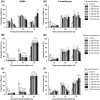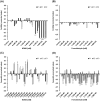Transgenerational Reproductive and Developmental Toxicity Induced by N-Nitrosodimethylamine and Its Metabolite Formaldehyde in Drosophila melanogaster
- PMID: 39775945
- PMCID: PMC11982778
- DOI: 10.1002/jat.4749
Transgenerational Reproductive and Developmental Toxicity Induced by N-Nitrosodimethylamine and Its Metabolite Formaldehyde in Drosophila melanogaster
Abstract
N-Nitrosodimethylamine (NDMA) is a known water disinfection byproduct (DBP) characterized as a potent hepatotoxin, promutagen, and probable human carcinogen; this is because of the metabolites associated with its biotransformation. The metabolism of NDMA produces formaldehyde, another alkylating agent and DBP. Both compounds are generated from natural and anthropogenic sources, but the safety restrictions applied to NDMA do not extend to the uses of formaldehyde. Hence, potential health and ecological risks are of concern. Due to limited information on the long-term effects of exposure to these compounds at environmentally relevant concentrations, this work aimed to compare the transgenerational reproductive and developmental toxicity of separate exposures to NDMA or its metabolite formaldehyde in Drosophila melanogaster over four generations. The parental flies were fed NDMA or formaldehyde (1.19E-06 to 5 mM) for 48 h during the third larval instar. Subsequent offspring (F1-F3) were grown under compound-free conditions. In the parental generation, both exposures modified the time to emergence and reduced the number of progenies. NDMA, but not formaldehyde, was lethal, affected fertility, and weakly induced malformations. In the next generations, both exposures induced malformed flies and modified the number of offspring. Reproductive toxicity and malformations were maintained for at least three generations, suggesting that detrimental effects could extend to unexposed offspring. This is the first study reporting the associated individual transgenerational effects on reproduction and development between NDMA and its metabolite formaldehyde in D. melanogaster, highlighting the relevance of evaluating multiple generations to accurately determine the health and environmental risks of pollutants.
Keywords: DBPs; Drosophila melanogaster; development; dimethylnitrosamine (DMN); fecundity; fertility; formalin; morphological alterations; parental exposure; reproduction.
© 2025 The Author(s). Journal of Applied Toxicology published by John Wiley & Sons Ltd.
Figures




Similar articles
-
NTP Developmental and Reproductive Toxicity Technical Report on the Prenatal Development Studies of 2-((1-(4-Phenoxyphenoxy)propan-2-yl)oxy)pyridine (CASRN 95737-68-1) in Sprague Dawley (Hsd:Sprague Dawley® SD®) Rats and New Zealand White (Hra:NZW SPF) Rabbits: DART Report 07 [Internet].Research Triangle Park (NC): National Toxicology Program; 2022 Jan. Research Triangle Park (NC): National Toxicology Program; 2022 Jan. PMID: 35593777 Free Books & Documents. Review.
-
Environmentally-relevant doses of bisphenol A and S exposure in utero disrupt germ cell programming across generations resolved by single nucleus multi-omics.Environ Health Perspect. 2025 Jun 3. doi: 10.1289/EHP16981. Online ahead of print. Environ Health Perspect. 2025. PMID: 40460421
-
Sexual Harassment and Prevention Training.2024 Mar 29. In: StatPearls [Internet]. Treasure Island (FL): StatPearls Publishing; 2025 Jan–. 2024 Mar 29. In: StatPearls [Internet]. Treasure Island (FL): StatPearls Publishing; 2025 Jan–. PMID: 36508513 Free Books & Documents.
-
Drosophila seminal sex peptide associates with rival as well as own sperm, providing SP function in polyandrous females.Elife. 2020 Jul 16;9:e58322. doi: 10.7554/eLife.58322. Elife. 2020. PMID: 32672537 Free PMC article.
-
Systemic pharmacological treatments for chronic plaque psoriasis: a network meta-analysis.Cochrane Database Syst Rev. 2021 Apr 19;4(4):CD011535. doi: 10.1002/14651858.CD011535.pub4. Cochrane Database Syst Rev. 2021. Update in: Cochrane Database Syst Rev. 2022 May 23;5:CD011535. doi: 10.1002/14651858.CD011535.pub5. PMID: 33871055 Free PMC article. Updated.
References
-
- AAT Bioquest, Inc . 2024. “Quest Graph™ LC50 Calculator.” AAT Bioquest. https://www.aatbio.com/tools/lc50‐calculator.
-
- Anand, A. S. , Verma K., Amitabh P., Prasad D., and Kohli E.. 2023. “The Interplay of Calponin, wnt Signaling, and Cytoskeleton Protein Governs Transgenerational Phenotypic Abnormalities in Drosophila Exposed to Zinc Oxide Nanoparticles.” Chemico‐Biological Interactions 369: 110284. 10.1016/j.cbi.2022.110284. - DOI - PubMed
-
- ATSDR (Agency for Toxic Substances and Disease Registry) . 2023. “Toxicological Profile for N‐Nitrosodimethylamine (NDMA).” Atlanta, GA, USA, April 2023. Accessed 5 May 2023. https://www.atsdr.cdc.gov/toxprofiles/tp141.pdf.
Publication types
MeSH terms
Substances
Grants and funding
LinkOut - more resources
Full Text Sources
Molecular Biology Databases
Miscellaneous

